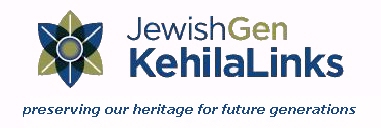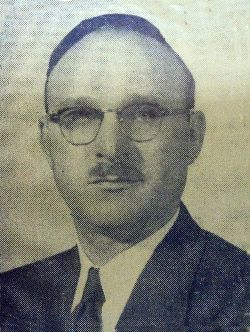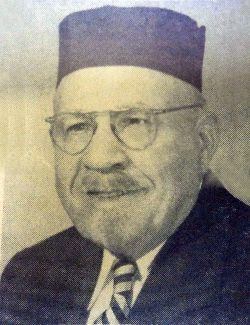| Uniontown Religious |
| (Click the images below to view a larger image.) |
| Uniontown, over time, had a Temple Israel Reformed congregation, a Tree of Life Orthodox (later Conservative, today Reformed) congregation, a Kosher butcher, a shochet (religious slaughterer) and a mohel (one who performs circumcisions). |
| In addition, over time, the congregations sponsored many worthwhile projects, such as Junior congregations, Sunday schools, weekly Cheder (Religious school) lessons, B'nai Brith mens' organization, Ladies' Auxiliary and Sisterhood and AZA/BBG youth organizations, Young Men's Association, Boy Scout Troop #6, Junior Hadassah, a basketball league, Bar Mitzvah Club and a nursery school for children aged three to five. Many of these organizations and programs eventually
moved to the Jewish Community Center. |
| ~ Temple Israel Jewish Community (Reformed) ~ |
|---|
| The first record of Jewish arrivals in Uniontown is found in 1882, when four Jewish families moved here. The names mentioned are A. FELDSTEIN, Harris and Barney COHEN and Max BAUM and S. ROSENBAUM. Mr. FELDSTEIN was the leader of the fledgling community and over time, the Jewish community continued grow. |
| The demarcation in religious lines were not very definite at that time, regardless, the handful of Jews kept alive their Judaism. Mr. Feldstein seems to have been a man of deep religious spirit and one of his first efforts in the direction of community effort, even on a small scale, was to intensify devotion to the tenets of the faith. He was the first to devote his attention to organization of religious services of a public character, but the group was too small to make any important attempt. |
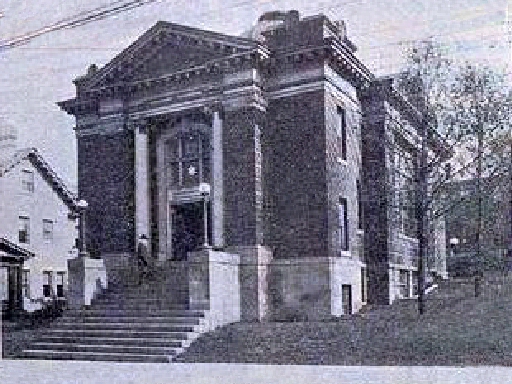 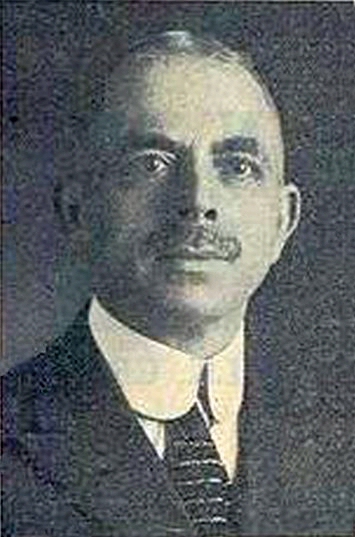 It was not until 1904, that a serious attempt was made to organize a congregation, from the Reform element in the community. This effort was due to Sol ROSENBAUM (pictured), one of the most respected and energetic members of the community. At first, the services were held in a hall, but in 1908, Temple Israel (pictured) was erected on East Fayette street at a cost of $25,000. |
| The building of a temple was a triumph on the part of the Jews of the community. An impressive dedication was held, officiated by Reverend Dr. Joseph KRAUSKOPF, of Philadelphia, who delivered the dedication sermon. It was an event of unusual interest in the city and non-Jews, as well as Jews, made of it an important occasion. |
| On 8 July 1904, Rabbi Isadore RICHART became the first rabbi of Temple Israel. After serving the congregation for three and a half years, he officiated his last service on 10 January 1908. By now, the congregation numbered 100. On 10 January 1908, William BAUM presented the congregation with a fine perpetual light for over the alter, in memory of his mother, Mrs. Max BAUM, who passed nine months before. |
| On 11 September 1908, Rabbi J. E. DOBRIN (of Cleveland, OH) succeeded Rabbi RICHART as rabbi of Temple Israel. Services were opened by Sol J. ROSENBAUM, who read the regular Friday night services. Rabbi DOBRIN resigned his charge on 30 April 1909. |
| Rabbi William LOWENBERG (of Philadelphia) succeeded Rabbi DOBRIN as rabbi of Temple Israel and officiated his first service on 28 October 1910. At this time, the officers of the congregation were Max BAUM (President), Lee STERN (Secretary) and the trustees were Sol J. ROSENBAUM, Joseph ROSENBAUM, Isadore FRANK, G.M. SILVERMAN and D. GOLDSTEIN. |
| When one considers that this congregation was established and maintained by a membership of some twenty or thirty families, it is a tribute to the Jewishness of the Reform group. Many communities of the time were much larger and could not even boast of an organized congregation, let alone a temple. Mr. Rosenbaum and his aides deserve the greatest credit for having done such an important work on behalf of their faith. By 1919, the officers of Temple Israel were Joseph ROSENBAUM (President), C. A. BERMAN (Vice President), Isaac ROSENBAUM (Secretary) and Lee STERN (Treasurer). All through the development of Uniontown Jewry, the following family names often appear: ROSENBAUM, BAUM, STEIN, SILVERMAN, FELS and others. These men have been in the forefront of every progressive Jewish movement of the time and did not hesitate to sacrifice their time and effort to promote the Jewish cause. |
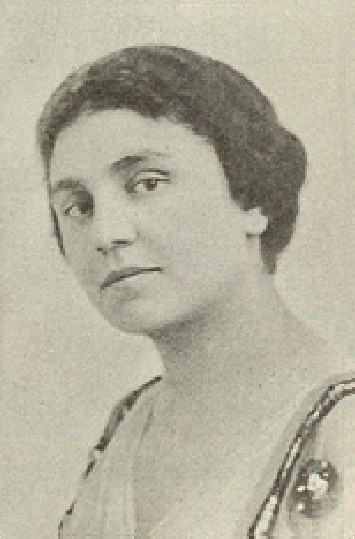 There was a well conducted Sabbath school in connection with the Temple, under the direction of Mrs. Isaac ROSENBAUM (Edna ROSENBERG of Pittsburgh, pictured) and her assistant was Mrs. Isadore SHEELHOFF. There were thirty pupils and all the Jewish holidays are observed by the children. Entertainment in connection with holidays such as Purim and Chanukah were held. There was a well conducted Sabbath school in connection with the Temple, under the direction of Mrs. Isaac ROSENBAUM (Edna ROSENBERG of Pittsburgh, pictured) and her assistant was Mrs. Isadore SHEELHOFF. There were thirty pupils and all the Jewish holidays are observed by the children. Entertainment in connection with holidays such as Purim and Chanukah were held.In addition to the Sabbath school, the women of the congregation organized a Ladies' Auxiliary Society and Sisterhood, which performed its part in promoting the general welfare of the congregational life. Mrs. Sol ROSENBAUM was the president of these societies and Miss Bertha Stern was the secretary. Sue to the women and their interest in congregational affairs, the progress and success of the work was assured. But the societies did not limit their entire effort to the Temple alone, but the influence of their effort was felt in other communal affairs. At this time, there were about 50 ladies who belonged to the Ladies' Auxiliary Society and Sisterhood. |
| The Reform Jews of Uniontown did their duty in supporting the WWI war effort by serving in the military, buying Liberty Bonds and Thrift Stamps, subscribing to the Red Cross or taking part in drives for War Relief or for the various welfare agencies such as the Y. M. C. A., K. of C. and Jewish Welfare Board. The Jewish community responded generously to the call of the country throughout the war. The men of the reform Jewish community that served in World War I military service were: Lawrence HIRSH, Alexander GOLDSTEIN, Julian ROSENBAUM, Nicholas ROSENBERG and Isaac and Lewis COHEN. Mr. Joseph ROSENBAUM was in-charge of a committee of Temple workers that raised several thousand dollars for "War Relief." In all other work, whether of a Jewish or non-Jewish character, they contributed their share. The women, too, did not lag in their duty, whether it was Red Cross sewing or in other kindred undertakings of a war character. |
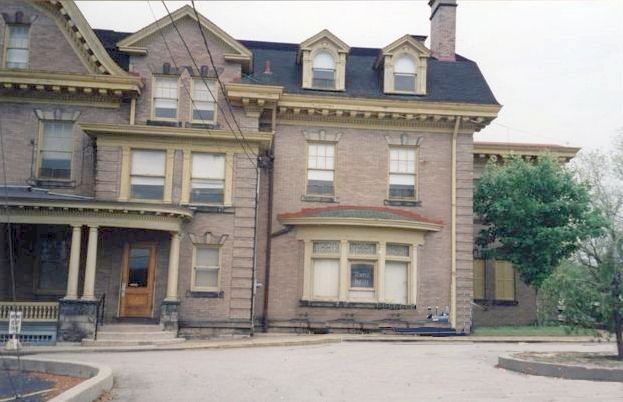 The Temple Israel building was sold some years ago and the congregation relocated to the Uniontown Jewish Community Center. A Temple Israel sign can be seen in the first floor window. A reformed rabbi, Rabbi Sion DAVID, still lives in Uniontown. (2011) If you have a history of Temple Israel congregation beyond 1919, e.g., anniversary year book, list and/or photos of religious leaders, etc., click HERE to contact me. |
| ~ Temple Israel Sanctuary ~ |
|---|
| If you have photos of the former Temple Israel Sanctuary, click HERE to contact me. |
| ~ Tree of Life Jewish Community (Orthodox) ~ |
|---|
|
|
| The Orthodox community did not organize into a congregation until 24 February 1902, when a small group of Jewish citizens of Uniontown applied to the Court of Common Pleas of Fayette County for a Charter of Incorporation to form a religious congregation to be known as the "Tree of Life." The purposes of the corporation were, "the support and maintenance of the public worship of Almighy G-d, according to the faith, doctrine, discipline and usages of the Jewish Orthodox Synagogues of
the United States." |
| The incorporators were Solomon COHEN, David FRIEDBERG, Louis E. RUBIN, David GOODSTEIN, Issac SILVERMAN, Jacob DAVIS, Harry MEYER, J. OGUSKY and Simon COHEN. The charter was granted and Solomon COHEN became the first official president. Jacob DAVIS was the first treasurer and Alolf HERSHKOVITZ was the first secretary. Mr. COHEN remained president until his death. In 1919, the officers were Harris COHEN (President), Ben DAVIS (Vice-president), J. TREELISKY (Secretary) and Joseph LEVENSON (Treasurer). |
| High Holy Day services were held in various public halls and Sabbath other weekly services were held at the home of Reverend Samuel COHEN, 57 Pittsburgh Street. On 8 July 1902, the congregation purchased the white school house on a lot on the corner of Beeson Avenue and Dunbar streets, where Asbury United Methodist Church is now located. This lot was sold when a second lot was purchased from the Uniontown School District. This lot was located between Iowa and East Fayette streets and contained a building known as the White School House. The building was remodeled and adapted to Jewish worship, with a seating capacity of 250. The dedicatgion service occurred 12 October 1808 officiatd by Rabbi SHINSKY, chief rabbi of the Orthodox Jews of Pittsburgh, who made the address. The Tree of Life congregation at this time numbered 50 members. |
| In 1919, the membership of the congregation was 55 members and Reverend Samuel COHEN was its rabbi. The Tree of Life Congregation had a well organized and efficiently conducted Sabbath school. The Ladies' Auxiliary of the Tree of Life performed excellent service, both as a congregational adjunct and in general communal affairs. They raised a splendid sum of money for the Jewish War Relief in WWI, as did the other members of the congregation. |
| The B'nai B'rith was established early in the intfantcy of the congregation and was always an active force in the Uniontown community. At the time of the establishment of the lodge, a committee came from Pittsburgh and at a meeting held at the Standard Club, the organization was brought into being. It measured up with other lodges of similar size. Joseph ROSENBAUM was its first president and was always an active worker in the order and always had a deep interest in its progress. The
other officers were Ben DAVIS (Vice-President), J. TREELISKY (Secretary) and Henry SINAY (Treasurer). By 1919, the lodge had a membership of 60 members who performed other work of a wider community value, beyond that which applies strictly to B'nai B'rith. All the good it has done has squared with its motto, "Benevolence, Brotherly Love and Harmony." |
| The Standard Club was the first Jewish institution that was built in Uniontown. It was, at one time, the center of all Jewish activities. In those rooms have been planned many important movements for the welfare of the religious and philanthropic, as well as the social phases of Jewish life in Uniontown. Like most social clubs, the burden of the work usually falls on the membership committee and in this case, the committee consisted of Louis ROSENBERG, Max COHEN and Harry SINAY. There were 60
members of the club. There are, of course, small groups of other young men and women who form social circles, but the Standard Club was the outstanding social organization of the community. Uniontown Jewry always occupied an important place among the smaller Jewish groups in the country and is often mentioned as the town where Jewish congresses were held. |
| A committee, consisting of A. FELDSTEIN, H. COHEN, J. DAVIS and E. GOODSTEIN, raised about eight thousand dollars for Jewish War Relief in WWI. The members of the congregation did their duty in all the various war activities that called for a patriotic response to WWI from all citizens of the community. |
| While this congregation was not officially a Zionist one, the largest percentage of the membership were affiliated with the Uniontown branch of the Zion Federation of America. Mr. Ben DAVIS was president and Mr. TREELISKY was secretary. There were about 110 members by 1919 and they are taking an active interest in the development of the movement, along the lines suggested by WEIZMANN and other eminent leaders. |
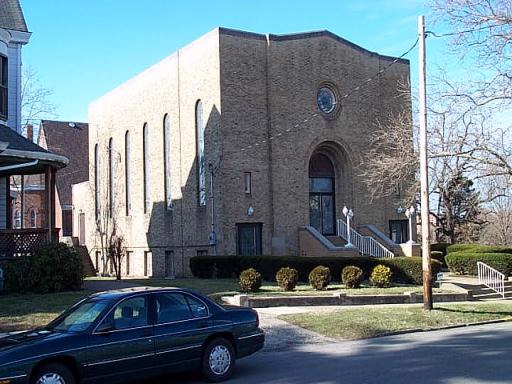 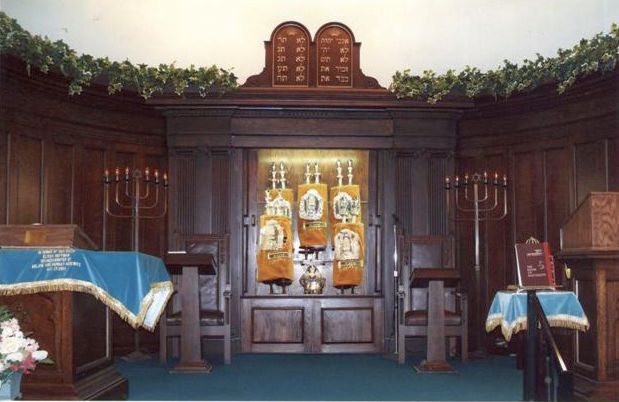 The present site of the Synagogue (pictured) was purchased on 10 May 1922. On 23 June 1925, the deed was turned over to the corporation and construction was completed, in 1925. Solomon COHEN is listed as the first official president of the congregation followed by Harris COHEN, David GOLDBERG, Morris FRIEDMAN and Abe COHEN. The present site of the Synagogue (pictured) was purchased on 10 May 1922. On 23 June 1925, the deed was turned over to the corporation and construction was completed, in 1925. Solomon COHEN is listed as the first official president of the congregation followed by Harris COHEN, David GOLDBERG, Morris FRIEDMAN and Abe COHEN.The first president of the Auxiliary was Mrs. Ben DAVIS succeeded by Mrs. Elias GOODSTEIN, Mrs. Mendel PERIL, Mrs. Esther HORELICK, and Mrs. STEIN. The first spiritual leader of the congregation was Reverend Samuel COHEN, followed by Rabbi's Samuel LEIBOWITZ, Morris MAX and Samuel GOLDBERGER. |
| The most accurate listing of leaders
and the years they served begins with the earliest journal—1938: |
Through the years, there was a very active religious school providing the Sunday school and Hebrew school education of our youths. Dedicated members served on the school board and as faculty. Adult Education classes were a regular feature of the education program. |
| The members and rabbis of the congregation have always taken an active part in community organizations and committees, such as the Red Cross, Heart Association, Rotary, Lions, United Fund, Chamber of Commerce, Bar Association, Medical Society and others. |
| Though a distincly seperate organization, the Chevra Kadisha (Burial Society) is associated with the synagogue and provided a beautiful burial ground at the Holy Society Cemetery in Hopwood, Pa. |
| The congregation, from its beginning, was an Orthodox congregation affiliated with the Union of Orthodox Jewish Congregations of America. Women and men were seated seperately, with the women in the balcony. There were gradual additions to the Orthodox congregation, but as with all Jewish communities—both large and small—there was a marked tendency to liberal ideas in Jewish life and Jewish worship, and eventually, the Orthodox community in Uniontown became a Conservative congregation. Over time, several milestones occurred with the change from an Orthodox to Conservative to a Reformed congregation:
|
| In 2015, the Tree of Life synagogue was sold and the memorial tablets were moved into a building at the cemetery. If you are interested in retrieving the memorial plate for a deceased loved one, you will need to visit the cemetery. |
| If you have anything to contribute concerning the Tree of Life congregation, e.g., history, list and/or photos of religious leaders, confirmation class photos, etc., click HERE to contact me.
|
| ~ Tree of Life Sanctuary ~ |
|---|
| If you have photos of the Tree of Life sanctuary, vestry, etc., click HERE to contact me. |
| ~ Tree of Life Auxillary ~ |
|---|
| In 1919, the women of the Tree of Life congregation formed the Auxiliary to handle social matters, carry on the traditions of Judaism and aid the congregation in all its aspects. The first president was Mrs. Ben DAVIS. |
| In 1925, during the presidency of Mrs. Alta PERIL, the congregation moved to its present site on Pennsylvania Avenue. The early years saw many fund raising activities, such as card parties at the Adelphia Club, food sales, rummage sales and dinners. Slowly, but steadily, funds trickled into the treasury to help defray the expenses of the synagogue. |
| In June, 1930, the first Donor Luncheon was held with Mrs. David LEBOWITZ as chairman. During the depression, through the 1930s, the women assumed the great burden of paying the interest on the mortgage, which was then $20,000. |
| The earliest minutes held are from September, 1931 through 1941. The secretaries of those years were Mrs. L. GOODSTEIN, Mrs. M. GOLDBERG, Bertha KOIDANOV, Ethel LEBOWITZ, and Sally KRONGOLD. These Women did an excellent job relating what transpired at the monthly meetings in remarkable detail and these minutes make for fascinating reading.
|
| Rabbi Julius WASHER started the Hashomer periodical and its arrival each month was eagerly anticipated. He inspired the women to publish an annual Ad Journal in order to pay off the mortgage. This tradition continues uninterrupted to this day. The Tree of Life archive has Ad Journals from 1938 through 2002. Proceeds from these books have enabled the women to remodel, repair, furnish and finance many needs of the Synagogue. |
| Great was the rejoicing when in March, 1943 president Mrs. David LEBOWITZ, Rabbi Samuel CHILL, president Abe COHEN and the members of the congregation saw the mortgage go up in flames. Now the ladies busied themselves with projects to remodel and refurnish the shule (synagogue). Every time you turned around, there was a dinner, a luncheon, an installation, a graduation, donors, plays, skits, picnics, breakfast minyons, confirmations, bar mitzvahs to keep the women and the kosher kitchen very busy. |
| The beneficiaries of much of the effort of the women thrugh the years were the religious school children. They enjoyed parties and latkies (poato pancakes) for Chanukah, hamentashen (triangle shaped cakes) and carnivals for Purim, model seders (Jewish ritual feast) for Passover, parties for Succos, fruits and nuts at Tu' B Shevat (New Year for Trees), and apples, candy and flags for Simchat Torah (Rejoicing with/of the Torah). |
| The 1960's, 70's and 80's saw much activity. Popular fund raisers were rummage sales, raffles, gift shop, bake sales, donor, yearbook, golden book and card parties. The May, 1967 minutes, gives an example of how the proceeds were spent to purchase "two complete sets of silverware to serve 175 people, new dishes for 200 people and starting the Rose WEISS Memorial Library. Three thousand dollars was allotted for new seats and carpeting for the synagogue and an additional $1,500.00 helped the synagogue board with its deficit." There were also joint luncheons with Temple Israel and Sisterhood Sabbaths each year. |
| The 80's and 90's saw declining membership through death and relocations. From humble beginnings to a high enrollment in the 50's of 130 members and back down to a membership of just 25 today (2011). Through the years the Sisterhood has earned and given many thousands of dollars to support the Tree of Life congregation. In 2000-2001, the Sisterhood gave the congregation $ 7,000.00, of which $5,500.00 as a free-will offering and $1,500.00 toward the purchase of ceiling fans for the sanctuary. Today, the Tree of Life Sisterhood is few, but mighty as a small nucleus of dedicated women continues the tradition of sewing our congregation. |
| ~ Uniontown Jewish Community Center ~ |
|
|---|---|
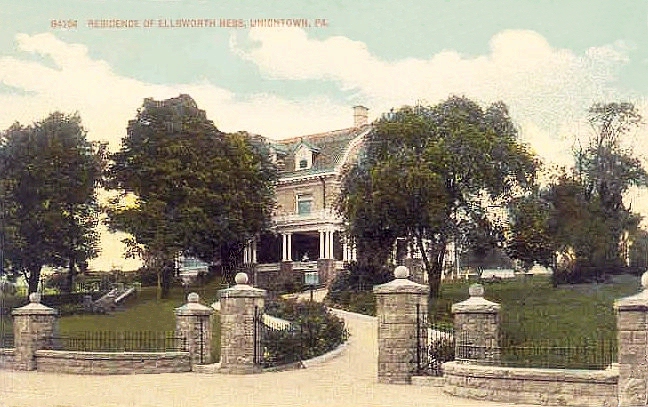 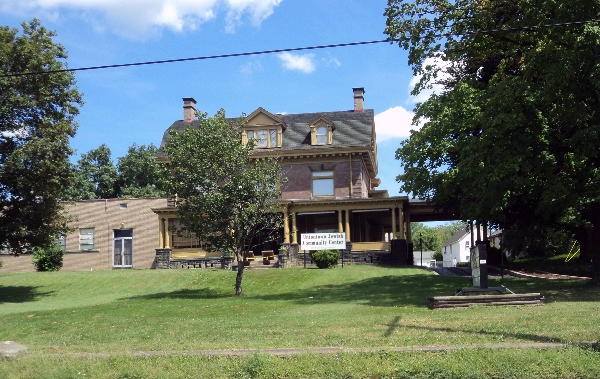 The former HESS Mansion—which passed through several ownerships—became the Jewish Community Center and focal point for many activities, for Jewish community of Uniontown and surrounding Jewish communities. |
|
| It had a library, Kosher kitchen and served as the meeting place for the Jewish service organizations. In subsequent years, an auditorium was added, swimming pool, play areas for the children, picnic areas, tennis court and basketball court. There was a "duck pin" bowling alley in the basement of the mansion and on the second floor, there was a pool table and card tables. |
|
| We cannot close without referring to the spirit of Uniontown Jewry, which was long lasting, due to the type of men and women who were its leaders and of course, the members of the Jewish community. |
|
|
|
| ~ Jewish Religious Leaders ~ |
||||||
|---|---|---|---|---|---|---|
| Following are images of the religious leaders of the Unionton congregations. If you have photograph to contribute, click HERE to contact me. |
||||||
| (Click the images below to view a larger image.) |
||||||
|
||||||
| ~ Uniontown Religious Schools ~ |
||||||
| Following are images of the religious school and
confirmation classes of the Uniontown congregations. If you have photograph to contribute, click HERE to contact me. |
||||||
| This page is hosted at no cost to the public by
JewishGen, Inc., a non-profit
corporation. If you feel there is a benefit to you in accessing this site,
your JewishGen-erosity is appreciated. |
| Compiled and created by: Marshall J. KATZ with assistance from A history of Uniontown: the county seat of Fayette County, PA by James Hadden, 1913 Pennsylvania Room at the Uniontown Library Rauh Jewish Archives at the Heinz History Center The Jewish Criterion - Vol. 51 No. 13 - 23 May 1919 Pittsburgh Jewish Newspaper Project, Carnegie Mellon University Libraries and the following JewishGen members/descendants and contributors of Uniontown Jewish families: Naomi BLOCH, USA Wolford SWIMMER, USA |
| Updated: 16 November 2015 |
| Copyright ©2011 Marshall J. KATZ All rights
reserved. |

|
Top of Page |
